Antihyperlipidemic Drugs lower serum levels of cholesterol and various lipids. They are also called as lipid-lowering agents; these drugs provide effective treatment for hyperlipidemia (increased lipid level in the blood). The incidence of coronary artery disease (CAD), the most common cause of death among adults, is higher in people with hyperlipidemia. High level of lipids and triglyceride is associated with metabolic syndrome consist of insulin resistance, abdominal obesity, hypertension, and proinflammatory and prothrombotic states.
Table of Contents
- Antihyperlipidemic: Generic and Brand Names
- Disease Spotlight: Coronary Artery Disease (CAD)
- Bile Acid Sequestrants
- HMG-CoA Reductase Inhibitors
- Cholesterol Absorption Inhibitors
- Practice Quiz: Antihyperlipidemic Drugs
- Recommended Resources
- See Also
- References and Sources
Antihyperlipidemic: Generic and Brand Names
Here is a table of commonly encountered antihyperlipidemic drugs, their generic names, and brand names:
- Bile Acid Sequestrants
- cholestyramine (Questran)
- colesevelam (Welchol)
- colestipol (Colestid)
- HMG-CoA Reductase Inhibitors
- atorvastatin (Lipitor)
- fluvastatin (Lescol)
- lovastatin (Mevacor)
- pitavastatin (Livalo)
- pravastatin (Pravanchol)
- simvastatin (Zocor)
- Cholesterol Absorption Inhibitor
- ezetimibe (Zetia)
- Fibrates
- fenofibrate (TriCor)
- fenofibric acid (Tripilix)
- gemfibrozil (Lopid)
- Vitamin B
- niacin (Niaspan)
Disease Spotlight: Coronary Artery Disease (CAD)
- Due to various reasons, fatty streaks begin to develop in the endothelium of coronary arteries. Over time, these fatty streaks develop into plaques (atheromas) and injure the lining of blood vessels. The inflammatory reaction begins, and it attracts white blood cells and platelets to the area. These cells collect on the injured vessels and cause the atheroma to grow bigger, further narrowing the diameter of blood vessels, and therefore, limiting the blood flow.
- The injury decreases the flexibility of the vessels, rendering it less distensible and less reactive to neurochemical stimuli. Coronary arteries are now unable to balance oxygen demand and blood supply.
- If not acted promptly, this can lead to total vessel blockage and vessel rupture. CAD is the leading cause of death worldwide, and its incidence is high in people with hyperlipidemia.
- The cause of CAD remains unknown, but certain risk factors were identified, and these include increasing age, male gender, sedentary lifestyle, smoking, obesity, high-fat diet, high-stress levels, menopause, and medical conditions like hypertension, gout, and diabetes.
Bile Acid Sequestrants
- These drugs are used to normalize high serum level of cholesterol.
Therapeutic Action
- Bile acid sequestrants exert their effect in the intestines by binding into bile acids which contain a high level of cholesterol.
- The resultant insoluble complex formed by this combination is then excreted through feces.
- As this happens, more LDL segments from the circulation will be absorbed by the intrahepatic circulation to make more bile acids.
Indications
- Bile Acid Sequestrants are used as the treatment for primary hypercholesterolemia (high cholesterol and high LDL) as an adjunct to diet and exercise.
- Cholestyramine is also used to treat pruritus associated with partial biliary obstruction.
Children
- Familial hypercholesterolemia treatment in children is limited to tight dietary restrictions of calorie and fats because lipids in children are important for the development of the nervous system. In cases that are unresponsive to dietary restrictions, other classes of antihyperlipidemic are used.
Adults
- Bile acid sequestrants are used in combination with HMG-CoA reductase inhibitors for patients whose lipid levels are challenging to normalize with the use of HMG-CoA reductase inhibitors alone.
- However, for pregnant women, bile acid sequestrants are the drug of choice in lowering cholesterol and lipid levels.
Older adults
- The impact of lipid-lowering agents in older adults is not supported by any outcome data. Instead, in taking care of this age group, reinforcement of lifestyle changes is given focus.
- Older adults are instructed on drugs that can’t be cut, crushed, and chewed.
Pharmacokinetics
- Not absorbed systemically and is excreted in the feces.
Contraindications and Cautions
- Allergy to bile acid sequestrants. Prevent severe hypersensitivity reactions.
- Complete biliary obstruction. Prevent bile from being secreted into the intestines.
- Abnormal intestinal function. Aggravated by the presence of bile acid sequestrants.
- Pregnancy and lactation. Potential decrease in absorption of fat and fat-soluble vitamins can be detrimental to fetus or neonate.
Adverse Effects
The adverse effects of bile acid sequestrants nurses need to watch out for are as follows:
- CNS: headache, anxiety, fatigue, drowsiness
- GI: GI upset, constipation, fecal impaction, nausea, aggravated hemorrhoids
- Hema: increased bleeding time, decreased production of clotting factors
- Musculoskeletal: muscle aches, muscle pains
- Other: rash, fat-soluble vitamin deficiencies
Interactions
- Bile acid sequestrants delay the absorption of thiazide diuretics, corticosteroids, digoxin, warfarin, and thyroid hormones. Therefore, if needed, these drugs are taken 1 hour before or 4-6 hours after a meal.
Nursing Considerations
Here are important nursing considerations when administering bile acid sequestrants:
Nursing Assessment
These are the important things the nurse should include in conducting assessment, history taking, and examination:
- Assess for the mentioned contraindications to prevent potential adverse effects.
- Conduct thorough physical assessment before beginning drug therapy to establish baseline status, determine effectivity of therapy and evaluate potential adverse effects.
- Obtain baseline status for weight while noting recent manifestations that increases or decreases to determine patient’s fluid status.
- Assess neurological status, particularly orientation and alertness to determine any CNS effects.
- Assess bowel elimination patterns, including frequency of stool passage and stool characteristics to monitor the development of constipation and possible fecal impaction.
- Assess closely patient’s heart rate and blood pressure to identify cardiovascular changes that may warrant change in drug dose
- Inspect abdomen for distention and auscultate bowel sounds to assess for changes in GI motility.
- Monitor results of laboratory tests, particularly serum cholesterol and lipid levels to evaluate the effectiveness of drug therapy.
Nursing Diagnoses
Here are some of the nursing diagnoses that can be formulated in the use of this drug for therapy:
- Acute pain related to CNS and GI effects
- Risk for injury related to CNS drug effects and potential for bleeding
- Altered elimination pattern related to constipation
Implementation with Rationale
These are vital nursing interventions done in patients who are taking bile acid sequestrants:
- Administer powdered agents already mixed with fluids to ensure drug effectiveness.
- Instruct client not to chew, crush, and cut tablets because these drugs are meant to be broken down in the intestines and premature crushing will render active ingredients ineffective.
- Administer drug before meals to ensure that drug is in the GI tract together with food.
- Administer other drugs 1 hour before or 4-6 hours after bile acid sequestrants to avoid drug interactions.
- Arrange for a bowel program to effectively address constipation if it ever occurs.
- Instruct patient to increase oral fluid intake and dietary fiber intake to prevent constipation.
- Provide comfort measures (e.g. small frequent meals for GI upset and instituting safety measures for drowsiness and weaknesses) to help patient tolerate drug effects.
- Educate patient on drug therapy including drug name, its indication, and adverse effects to watch out for to enhance patient understanding of drug therapy and thereby promote adherence to drug regimen.
Evaluation
Here are aspects of care that should be evaluated to determine effectiveness of drug therapy:
- Monitor patient response to therapy (serum lipid and cholesterol levels).
- Monitor for adverse effects (e.g. headache, vitamin deficiency, and increased bleeding times.
- Evaluate patient understanding on drug therapy by asking the patient to name the drug, its indication, and adverse effects to watch for.
- Monitor patient compliance to drug therapy.
HMG-CoA Reductase Inhibitors
- This drug group increases the cell absorption of LDL by blocking the enzyme (HMG-CoA reductase) regulating the rate-limiting step in the synthesis of cholesterol. With this alteration in fat metabolism, HDL increases slightly.
- Drugs under this classification are chemically-modified compounds from the products of fungi.
Therapeutic Action
- In a sense, HMG-CoA reductase inhibitors block the completion of cholesterol synthesis in the body.
- These are primarily indicated as adjunct medicine with diet and exercise for treatment of high cholesterol and LDL levels in the blood.
Indications
- Pravastatin, lovastatin, and simvastatin are indicated for patients with documented CAD to slow progression of the disease.
- Together with these three agents, atorvastatin is used as prophylaxis for first myocardial infarction attack for patients with multiple risk factors for CAD.
Children
- Treatment for familial hypercholesterolemia for this age group is strictly limited to tight dietary restrictions from fats and calories because lipids in this age group are important for the development of nervous system.
Adults
- HMG-CoA reductase inhibitor is the drug of choice for patients who have multiple risk factors or have already developed CAD.
- The importance of lifestyle changes (e.g. dietary restrictions, regular exercise, and smoking cessation) should be emphasized to this age group.
- This class is well-tolerated and is less expensive compared to other classes with the same therapeutic effect. For cases who are slow to respond to this class alone, combination therapy with niacin, fibrate, and bile acid sequestrants is instituted.
- PREGNANCY CATEGORY X For women who are pregnant, this drug class is contraindicated (pregnancy category X).
Older adults
- Are more susceptible to drug toxicity because of underlying conditions that would interfere with metabolism and excretion of drug.
- Importance of mentioned lifestyle changes should also be emphasized.
Pharmacokinetics
| Route | Onset | Peak | Duration |
| Oral | Slow | 1-2 h | 20-30 h |
| T1/2: 14 h Metabolism: liver Excretion: bile |
Contraindications and Cautions
- Allergy to HMG-CoA reductase inhibitors. Prevent severe hypersensitivity reactions.
- Active liver disease. Exacerbated by drug’s therapeutic effect and has potential to lead to severe liver failure.
- Pregnancy, lactation. Potential for drug adverse effects to fetus or neonate.
- Impaired endocrine function. Problems can arise due to alteration in the formation of steroid hormones.
- Renal impairment. Caution is given to patients taking other statins and close monitoring in instituted. Atorvastatin is not affected by renal diseases.
Adverse Effects
- CNS: headache, dizziness, insomnia, fatigue, blurred vision, cataract development
- CV: increased risk for cardiovascular effects with simvastatin started at 80 mg for new patients
- GI: flatulence, nausea, vomiting, cramps, abdominal pain, constipation
- Hepatobiliary: increase liver enzymes, acute liver failure with use of atorvastatin and fluvastatin
Interactions
- Cyclosporine, erythromycin, gemfibrozil, niacin, antifungal drugs: increased risk for rhabdomyolysis
- Digoxin, warfarin: increased serum levels and resultant toxicity of HMG-CoA reductase inhibitors
- Oral contraceptives: increased serum estrogen
- Grapefruit juice: increased serum levels and resultant toxicity
Nursing Considerations
Here are important nursing considerations when administering HMG-CoA reductase inhibitors:
Nursing Assessment
These are the important things the nurse should include in conducting assessment, history taking, and examination:
- Assess for the mentioned contraindications to this drug (e.g. hypersensitivity, acute liver disease, pregnancy etc.) to prevent potential adverse effects.
- Conduct thorough physical assessment before beginning drug therapy to establish baseline status, determine effectivity of therapy, and evaluate potential adverse effects.
- Obtain baseline status for weight while noting recent manifestations that increases or decreases to determine patient’s fluid status.
- Assess neurological status with particular focus on consciousness, reflexes, and affect.
- Assess closely patient’s heart rate and blood pressure to identify cardiovascular changes that may warrant change in drug dose.
- Assess bowel patterns to determine possibility of developing constipation and resultant fecal impaction.
Nursing Diagnoses
Here are some of the nursing diagnoses that can be formulated in the use of this drug for therapy:
- Disturbed sensory perception related to CNS effects
- Risk for injury related to CNS effects
Implementation with Rationale
These are vital nursing interventions done in patients who are taking HMG-CoA reductase inhibitors:
- Administer drug at bedtime to maximize effectiveness of the drug because peak of cholesterol synthesis is from midnight to 5 AM. However, atorvastatin can be given at any hour of the day.
- Monitor serum cholesterol and LDL levels to determine effectiveness of drug therapy.
- Monitor results of liver functions tests to determine possible liver damage.
- Ensure patient has initiated a 3-6 month diet and exercise program before initiating drug therapy to ensure need for drug therapy.
- Emphasize the importance of lifestyle changes to the patient to decrease risk of CAD and promote drug effectiveness.
- Provide comfort and safety measures to help patient tolerate drug side effects.
- Educate patient on drug therapy including drug name, its indication, and adverse effects to watch out for to enhance patient understanding on drug therapy and thereby promote adherence to drug regimen.
Evaluation
Here are aspects of care that should be evaluated to determine effectiveness of drug therapy:
- Monitor patient response to therapy as evidenced by normal serum cholesterol and LDL levels, absence of first MI, and slowing of CAD progression.
- Monitor for adverse effects (e.g. cataracts, rhabdomyolysis, and acute liver disease).
- Evaluate patient understanding on drug therapy by asking patient to name the drug, its indication, and adverse effects to watch for.
- Monitor patient compliance to drug therapy.
Cholesterol Absorption Inhibitors
- Cholesterol absorption inhibitors are one of the new class of drugs approved (2003) to lower serum cholesterol levels.
- A controversy is linked to this drug because a study in 2008 failed to show positive benefits of combining this class to statins. However, further studies are needed to validate this alleged lack of effect of cholesterol-lowering agents.
Therapeutic Action
The therapeutic action of cholesterol absorption inhibitors are as follows:
- Acting on the brush border of intestines, cholesterol absorption inhibitors block the absorption of dietary cholesterol. Consequently, less cholesterol goes to the liver and it increases the cholesterol clearance to make up for the drop.
Indications
Cholesterol absorption inhibitors are indicated as follows:
- Adjunct to diet and exercise as a monotherapy or in combination with HMG-CoA inhibitors or bile acid sequestrants.
- Used in combination with statins to treat homozygous familial hypercholesterolemia.
Children
- Not indicated for this age group.
Adults
- Used in combination with HMG-CoA inhibitors or bile acid sequestrants.
- The importance of lifestyle changes (e.g. dietary restrictions, regular exercise, and smoking cessation) should be emphasized to this age group.
- Effect to fetuses and neonates is not known.
Older adults
- Are more susceptible to drug toxicity because of underlying conditions that would interfere with metabolism and excretion of drug.
- Importance of mentioned lifestyle changes should also be emphasized.
Pharmacokinetics
Contraindications and Cautions
Cholesterol absorption inhibitors are contraindicated with the following:
- Allergy to cholesterol absorption inhibitors. Prevent severe hypersensitivity reactions.
- Liver disease, pregnancy, lactation: not used if combined with statins because of the effects of statins to these health conditions. Effect of this class to fetuses and neonates is not known.
Adverse Effects
The adverse effects of cholesterol absorption inhibitors are as follows:
- CNS: headache, dizziness, fatigue
- Respiratory: upper respiratory tract infection (URI)
- GI: mild abdominal pain, diarrhea
- Musculoskeletal: muscle aches and pains, back pain
Interactions
Assess the interaction of the drug with the following:
- Cholestyramine, fenofibrate, antacid, gemfibrozil: elevated serum level of cholesterol absorption inhibitors
- Cyclosporine: increased toxicity of cholesterol absorption inhibitors
- Fibrates: increased risk for development of cholelithiasis
- Warfarin: increased serum warfarin levels
Nursing Considerations
Here are important nursing considerations when administering cholesterol absorption inhibitors:
Nursing Assessment
These are the important things the nurse should include in conducting assessment, history taking, and examination:
- Assess for the mentioned contraindications to this drug (e.g. hypersensitivity, acute liver disease, pregnancy etc.). To prevent potential adverse effects.
- Conduct thorough physical assessment before beginning drug therapy. To establish baseline status, determine effectivity of therapy and evaluate potential adverse effects.
- Assess neurological status. Give with a particular focus on orientation and reflexes to determine CNS drug effects.
- Assess closely patient’s heart rate and blood pressure. To identify cardiovascular changes that may warrant a change in drug dose.
- Assess bowel patterns. To determine the possibility of developing constipation and resultant fecal impaction.
- Monitor laboratory test results of serum cholesterol, LDL, and liver function. To determine the potential for drug adverse effects and monitor effectiveness of therapy.
Nursing Diagnoses
Here are some of the nursing diagnoses that can be formulated in the use of this drug for therapy:
- Disturbed sensory perception related to CNS effects
- Acute pain related to side-effect of drugs as evidenced by headache, myalgia, and GI distress
- Risk for injury related to CNS effects
Implementation with Rationale
These are vital nursing interventions done in patients who are taking cholesterol absorption inhibitors:
- Monitor serum cholesterol and LDL levels. To determine the effectiveness of drug therapy.
- Monitor results of liver functions tests. To determine possible liver damage.
- Ensure patient has initiated a 3-6 month diet and exercise program before initiating drug therapy. To ensure the need for drug therapy.
- Emphasize the importance of lifestyle changes. To the patient to decrease the risk of CAD and promote drug effectiveness.
- Provide comfort and safety measures. To help patient tolerate drug side effects.
- Educate patient on drug therapy. Include in the teaching plan the drug name, its indication, and adverse effects to watch out for to enhance patient understanding of drug therapy and thereby promote adherence to the drug regimen.
Evaluation
Here are aspects of care that should be evaluated to determine effectiveness of drug therapy:
- Monitor patient response to therapy as evidenced by normal serum cholesterol and LDL levels.
- Monitor for adverse effects (e.g. muscle pains, respiratory infections, headache).
- Evaluate patient understanding on drug therapy by asking patient to name the drug, its indication, and adverse effects to watch for.
- Monitor patient compliance to drug therapy.
Practice Quiz: Antihyperlipidemic Drugs
Quiz time! Take our 7-item quiz about antihyperlipidemic drugs–perfect practice quiz for your NCLEX exam!
1. Lipid levels of individuals with coronary artery disease (CAD) is usually high. All of the following are factors of CAD, except:
A. Men
B. Gout
C. Untreated Chlamydia infections
D. None of the above
2. Antihyperlipidemic agent that is used to decrease plasma cholesterol levels.
A. HMG-CoA reductase inhibitors
B. Phosphodiesterase inhibitors
C. Bile acid sequestrants
D. Cholesterol absorption inhibitor
3. A pregnant woman needs a lipid-lowering agent. What would be the best class of lipid-lowering agent for pregnant women?
A. HMG-CoA reductase inhibitors
B. Bile acid sequestrants
C. Cholesterol absorption inhibitors
D. Phosphodiesterase inhibitors
4. The only statin with outcome data to show effectiveness in decreasing CAD and incidence of myocardial infarction.
A. atorvastatin (Lipitor)
B. simvastatin (Zocor)
C. pravastatin (Pravachol)
D. fluvastatin (Lescol)
5. Which of the following medical conditions will render antihyperlipidemics ineffective?
A. biliary obstruction
B. diabetes mellitus
C. both A and B
D. none of the above
6. This drug works on the brush border of the intestines.
A. ezetimibe
B. pitavastatin
C. gemfibrozil
D. colestipol
7. A patient who is taking a bile acid sequestrant complains of abdominal distention and nausea. What should the nurse do?
A. Document, withdraw drug, and notify doctor.
B. Provide comfort measures.
C. Prepare emergency equipment at bedside.
D. Dismiss the complaint.
8. What vitamin plays a role in lowering cholesterol concentration?
A. Vitamin C
B. Vitamin E
C. Vitamin B3
D. Vitamin B2
9. When should statins be taken to maximize its therapeutic effects?
A. After meals
B. During meals
C. At night
D. In the mornings
10. The doctor ordered atorvastatin for an obese client’s hyperlipidemia. This patient is receiving erythromycin for a toe infection at the same time. The nurse knows that this combination should be avoided because?
A. It increases risk of atorvastatin toxicity.
B. It can result to potentially fatal lipolysis.
C. It can result to breakdown of muscles.
D. It decreases the effectiveness of erythromycin.
Answers and Rationale
1. Answer: D. None of the above.
The incidence of CAD in men is higher than premenopausal women. Gout injures the blood vessels because of accumulation of uric acid. Untreated bacterial infections can also contribute to CAD.
2. Answer: C. Bile acid sequestrants.
Bile acid contains a lot of cholesterol and bile acid sequestrants bind to them to form an insoluble complex that is then excreted in the feces.
3. Answer: B. Bile acid sequestrants.
This is the drug of choice for women of childbearing age. HMG-CoA reductase inhibitor is pregnancy category X.
4. Answer: C. pravastatin (Pravachol).
Pravastatin is an HMG-CoA reductase inhibitor that can prevent first MI even in patients who do not have documented increase in cholesterol concentration.
5. Answer: A. biliary obstruction.
This condition can interfere with the mechanism of action of the drug, thereby reducing its effectiveness.
6. Answer: A. ezetimibe.
It belongs to cholesterol absorption inhibitor class and by acting on the brush border of the intestines, absorption of cholesterol is not allowed.
7. Answer: B. Provide comfort measures.
GI discomforts as evidenced by abdominal distention, nausea, and vomiting are common complaints by patients taking bile acid sequestrants. The nurse should provide comfort measures to help patients tolerate drug effects.
8. Answer: C. Vitamin B3.
Niacin is used as a treatment for hyperlipidemia that does not respond to diet and weight loss.
9. Answer: C. At night.
It is when the liver is processing the most lipids (midnight to 5 AM).
10. Answer: C. It can result in breakdown of muscles.
Rhabdomyolysis can occur if statins are combined with erythromycin, cyclosporine, and antifungal drugs. Waste products from this muscle breakdown injure glomeruli and can lead to acute renal failure.
Recommended Resources
Our recommended nursing pharmacology resources and books:
Disclosure: Included below are affiliate links from Amazon at no additional cost from you. We may earn a small commission from your purchase which will help support us. Thank you! For more information, check out our privacy policy.
Pharm Phlash! Pharmacology Flash Cards #1 BEST SELLER!
Test-yourself review cards put critical clinical information for nearly 400 of the top generic medications at your fingertips. And, you can count on them for accuracy, because each card is based on content from Davis’s Drug Guide for Nurses. Increase your test scores in pharmacology class.
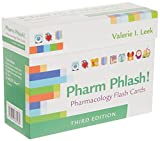
Focus on Pharmacology (8th Edition)
Focus on Nursing Pharmacology makes challenging concepts more approachable. Engaging learning features cultivate your clinical application, critical thinking and patient education capabilities. This updated 8th edition builds on your knowledge of physiology, chemistry and nursing fundamentals to help you conceptualize need-to-know information about each group of drugs.
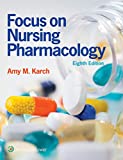
Pharmacology Made Incredibly Easy (Incredibly Easy! Series®)
Nursing pharmacology guide offers step-by-step guidance so you can grasp the fundamentals in enjoyable Incredibly Easy style. This is the perfect supplement to class materials, offering solid preparation for NCLEX® as well as a handy refresher for experienced nurses. Colorfully illustrated chapters offer clear, concise descriptions of crucial nursing pharmacology concepts and procedures.
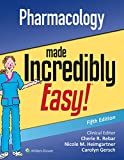
Lehne’s Pharmacology for Nursing Care (11th Edition)
The Eleventh Edition of Lehne’s Pharmacology for Nursing Care provides a thorough understanding of key drugs and their implications for nursing care. This text, written by renowned nursing educators, helps you comprehend and apply pharmacology principles. A clear and engaging writing style simplifies complex concepts, making even the most challenging pharmacology content enjoyable. We recommend this book if you want a comprehensive nursing pharmacology guide.
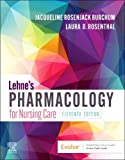
Nursing Drug Handbook
Nursing2023 Drug Handbook delivers evidence-based, nursing-focused drug monographs for nearly 3700 generic, brand-name, and combination drugs. With a tabbed, alphabetical organization and a “New Drugs” section, NDH2023 makes it easy to check drug facts on the spot.
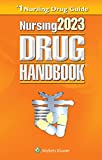
Pharmacology and the Nursing Process
The 10th edition of Pharmacology and the Nursing Process offers practical, user-friendly pharmacology information. The photo atlas contains over 100 unique illustrations and photographs depicting drug administration techniques. Updated drug content reflects the most recent FDA drug approvals, withdrawals, and therapeutic uses.
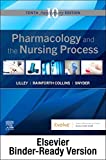
Mosby’s Pharmacology Memory NoteCards: Visual, Mnemonic, and Memory Aids for Nurses
The 6th edition of Mosby’s Pharmacology Memory NoteCards: Visual, Mnemonic, & Memory Aids for Nurses incorporates illustrations and humor to make studying easier and more enjoyable. This unique pharmacology review can be utilized as a spiral-bound notebook or as individual flashcards, making it ideal for mobile study.
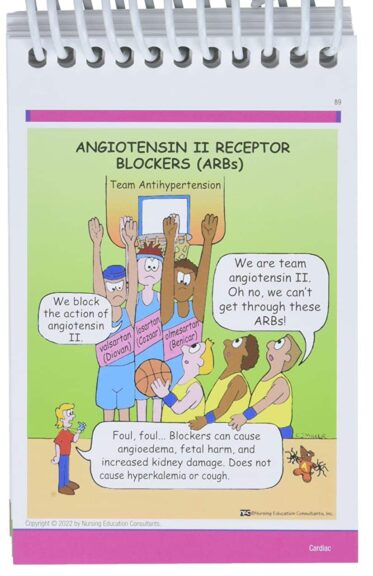
See Also
Here are other nursing pharmacology study guides:
- Nursing Pharmacology – Study Guide for Nurses
Our collection of topics related to nursing pharmacology - Pharmacology Nursing Mnemonics & Tips
These nursing mnemonics aim to simplify the concepts of pharmacology through the use of a simple, concise guide. - Generic Drug Name Stems Cheat Sheet
Learn about these generic drug name stems to help you make sense of drugs easier! - Common Drugs and Their Antidotes
A guide to drug antidotes that nurses should be familiar about. - IV Fluids and Solutions Guide & Cheat Sheet
Get to know the different types of intravenous solutions or IV fluids in this guide and cheat sheet. - Drug Dosage Calculations NCLEX Practice Questions (100+ Items)
Care to take the challenge? This quiz aims to help students and registered nurses alike grasp and master the concepts of medication calculation.
Drug Guides NEW!
Individual drug guides and nursing considerations for the most common medications used in nursing pharmacology:
- Acetaminophen (Tylenol)
- Aspirin
- Atorvastatin (Lipitor)
- Enoxaparin (Lovenox)
- Furosemide (Lasix)
- Gabapentin
- Hydromorphone (Dilaudid)
- Lisinopril
- Metoprolol
- Morphine
Gastrointestinal System Drugs
Respiratory System Drugs
- Antihistamines
- Bronchodilators and Antiasthmatics
- Decongestants
- Expectorants and Mucolytics
- Inhaled Steroids
- Lung Surfactants
Endocrine System Drugs
- Adrenocortical Agents
- Antidiabetic Agents
- Glucose-Elevating Agents
- Hypothalamic Agents
- Insulin
- Parathyroid Agents: Bisphosphonates, Calcitonins
- Pituitary Drugs
- Sulfonylureas
- Thyroid Agents
Autonomic Nervous System Drugs
- Adrenergic Agonists (Sympathomimetics)
- Adrenergic Antagonists (Sympatholytics)
- Anticholinergics (Parasympatholytics)
- Cholinergic Agonists (Parasympathomimetics)
Immune System Drugs
Chemotherapeutic Agents
- Anthelmintics
- Anti-Infective Drugs
- Antibiotics
- Antifungals
- Antineoplastic Agents
- Antiprotozoal Drugs
- Antiviral Drugs
Reproductive System Drugs
Nervous System Drugs
- Antidepressants
- Antiparkinsonism Drugs
- Antiseizure Drugs
- Anxiolytics and Hypnotic Drugs
- General and Local Anesthetics
- Muscle Relaxants
- Narcotics, Narcotic Agonists, and Antimigraine Agents
- Neuromuscular Junction Blocking Agents
- Psychotherapeutic Drugs
Cardiovascular System Drugs
References and Sources
References and sources for this pharmacology guide for Antihyperlipidemic Agents:
- Karch, A. M., & Karch. (2011). Focus on nursing pharmacology. Wolters Kluwer Health/Lippincott Williams & Wilkins. [Link]
- Katzung, B. G. (2017). Basic and clinical pharmacology. McGraw-Hill Education.
- Lehne, R. A., Moore, L. A., Crosby, L. J., & Hamilton, D. B. (2004). Pharmacology for nursing care.
- Smeltzer, S. C., & Bare, B. G. (1992). Brunner & Suddarth’s textbook of medical-surgical nursing. Philadelphia: JB Lippincott.
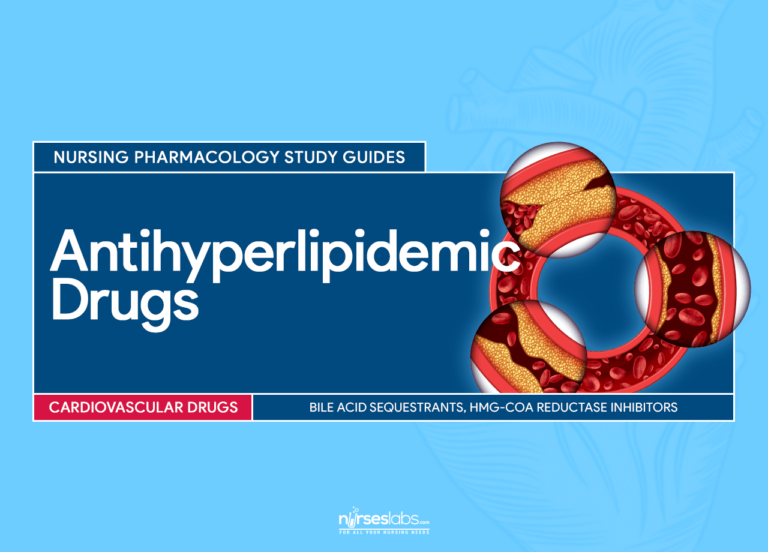
Thanks 👍 nice work